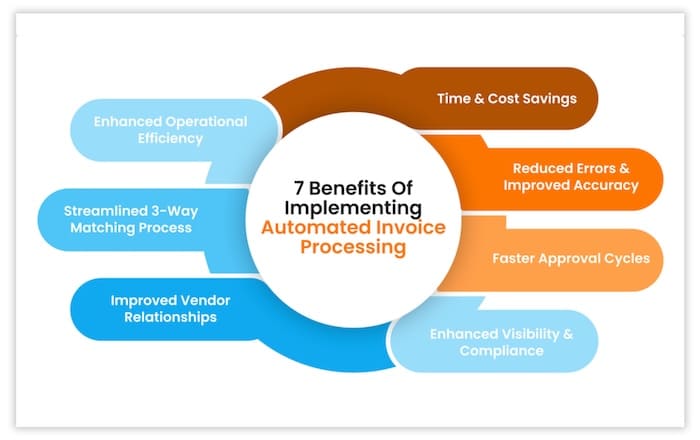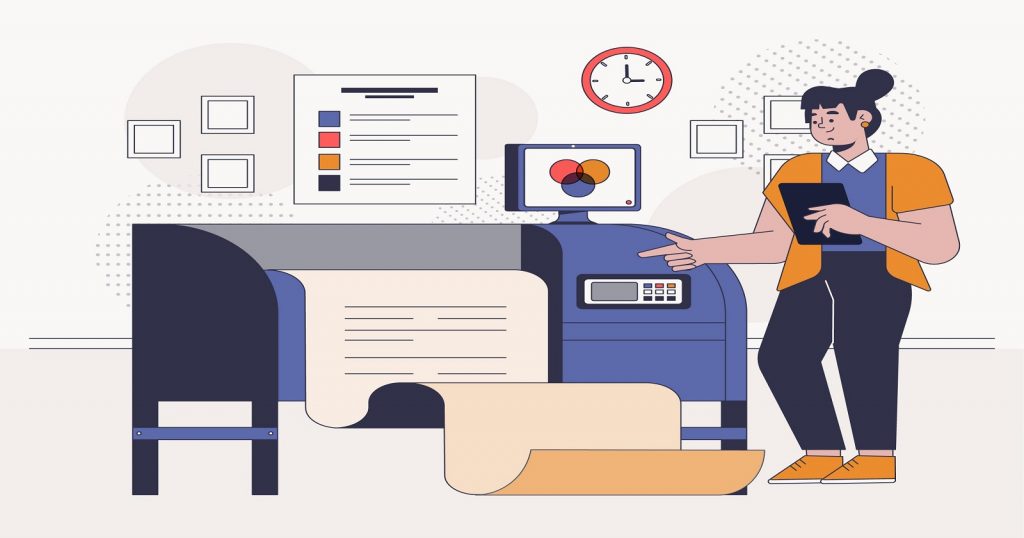For good reasons, invoice approval workflow is increasingly becoming an essential part of transactions. It is fast, reliable, error-free, and is a good countermeasure against fraud.
But what is invoice approval workflow and why is everyone obsessed with it?
Invoice approval workflow involves structuring and streamlining invoice creations, reviews, approvals, and payments. It can be done manually, or automated with some of the best invoicing software.
If your business gets overwhelmed with payment issues all the time, we may just have the solution. Keep reading to learn more.
What Is an Invoice Approval Workflow? Key Components and Steps

Image via DocuClipper
Invoice approval workflow is a step-by-step process that helps organizations operate their invoicing systems. It’s a set of guidelines that dictate how invoices are created, reviewed, approved, and paid.
While these guidelines may vary from one business to another, some key components tie them all together. These include the following.
Invoice Submission
This is where the invoice approval process begins. First, the vendor submits an invoice to your business through email or a preferred digital portal. The invoice is automatically logged into the accounting system.
Invoicing is automated from the very first stage to ensure all details are captured. This avoids any issues later on during payments. Businesses use Optical Character Recognition (OCR) technology to help reduce human error in their invoice approval workflow.
Review and Verification
The invoice is thoroughly reviewed to verify whether the details match the purchase order or related contract terms. Verified details include vendor information, quantities, prices, and due dates.
This is a crucial invoice approval workflow stage, where discrepancies are caught to prevent overpayments, underpayments, and double payments. This also helps in detecting fraud by spotting deliberate mismatches.
Approval Process
Once the invoice data passes the verification checks, it’s ready to receive the green light. However, for most businesses, this may require the signatures of multiple stakeholders.
You can use dedicated invoicing software to accelerate this process by notifying the signatories. This will not only ensure vendors get paid on time, but it will also record everything for accountability purposes.
You May Also Like:
Payment Authorization
This is the final invoice approval workflow stage, where your finance department schedules payments based on cash flow availability. The idea is to deliver timely payments that keep vendors happy.
Why Is an Invoice Approval Workflow Process Important?
Invoice approval workflow processes can sometimes feel unnecessarily long, especially if you’re on the receiving end. However, there are good reasons behind this, and the following are some of the most notable ones.
Prevents Fraud and Errors
Invoice fraud is one of the most common financial crimes and it’s easy to fall victim. Fortunately for businesses, a structured invoice approval workflow can prevent fraudulent invoices from passing through.
By the time the invoice reaches the approval stage, it has undergone multiple checks and it has been signed off by different people. A red flag may escape one person, but it is unlikely that this mistake will go through two or three people.
AI technology can be used in the invoice approval workflow process to help detect anomalies that would otherwise fool a human. These anomalies include duplicate payments, doctored amounts, and forged signatures.
Enhances financial accountability
When an invoice has to go through multiple people before it gets deposited, there is a higher level of transparency involved. Every single stage from submission to payment is recorded and signed on, leaving a clear audit trail.
This is the level of transparency that helps small businesses maintain clean bookkeeping. The ability to quickly track a discrepancy will also reflect well on your company, as it shows how much you care about settling your dues the right way.
You May Also Like:
Increases Efficiency
One of the most relevant things an automated workflow brings to the table is efficiency. Streamlining your invoice processing reduces bottlenecks and frees up everyone.
Take for example software that notifies invoice signatories that they have to approve payments. Rather than having to physically come to the office for that, they can do it remotely, saving their time and the company’s money.
Improves Vendor Relationships
A paid vendor is a happy vendor, and a vendor who gets paid on time will also deliver on time. Unsettled and delayed payments are a thorn in every corporation and LLC. Nobody wants to work with businesses that don’t deliver on their end.
Timely payments will significantly improve your standing with everyone you do business with. This can have a ripple effect on your business in terms of future discounts, better transaction deals, and priority service.
An efficient invoice approval workflow cuts down the time it takes for an invoice to be submitted and paid.
Provides Real-Time and Transparent Tracking
When you automate your invoice approval workflow, everyone involved has visibility over the process. They get real-time updates on the status of the invoice, tracking it through every point of the process.
This has two main benefits. First, it makes it easy to follow up in case of approval delays and understand who is stalling the process. Secondly, it makes it easy to update suppliers on the status of their payment.
You May Also Like:
How to Implement an Invoice Approval Workflow

Image via highradius
You may have the right accounting software and people, but getting things to work takes more than that. Here are some of the best practices to implement an invoice approval workflow and maximize results.
1. Define Your Workflow Stages
Map out every step that the invoice needs to take before money is deposited into the vendor’s account. As I mentioned earlier, every business has its way of doing things.
Some prefer manual invoice approval processes over automation.
Overall, if you are having any doubts, try to stick to the default guide. Start with invoice submission and review, followed by approval, and finally, payment authorization.
Document each step clearly to ensure that everyone in your finance team understands what’s expected of them.
2. Choose the Right Software
Invoice approval automation is the key, especially when you’re an ecommerce business that handles multiple vendors. However, finding the right software for your invoice approval workflow could be the difference between order and chaos.
There are some things to consider when choosing invoicing software for your business.
- Automation features: You need a program that eliminates manual data entry. It should support OCR or similar tech that digitizes paper invoices and routes them through your workflow without issues.
- Customization: Since every business has its own approval process, your choice of software should be flexible. There should be room for setting up custom approval hierarchies that best fit the needs of the business.
- Integrations: The chosen software shouldn’t be siloed, but rather collaborate with other tools. Your invoice approval software should play nicely with your existing systems. Smooth integrations mean less switching between platforms which can be time-consuming and costly.
- Real-time reporting: You need to keep an eye on all stages of the invoicing process. Therefore, choose software that offers real-time reports and flags any discrepancies, overdue invoices, and more.
3. Set Up Approval Hierarchies
Approval hierarchies refer to the structured invoice approval workflows that determine the chain of command. It tells you who needs to review and approve what and when.
While involving extra people may make the invoicing process foolproof, it can also introduce unnecessary bottlenecks. Not every invoice requires the CEO’s signature. Delegate that role to speed up the process and maintain good customer relations.
You can also automate routing so that invoices reach the right approvers based on your set thresholds. This eliminates the cat-and-mouse game of chasing down signatures and delaying payments.
You May Also Like:
4. Prepare Your Team
Now your automated invoice approval workflow system is in place,but what about your staff? Are they up to the task?
Changing business processes is hard and it’s not always met with smiling faces. The final piece requires you to bring your team up to speed with the new changes. To ensure success, you’ll need the following:
- Training sessions: Hold comprehensive training sessions and seminars that walk your team through the new invoice approval workflow. This must cover software navigation and approval protocols. They should also familiarize themselves with a manual invoice approval process just in case automation fails or the system crashes.
- User guides: Some people grasp things faster by reading or watching tutorials. So incorporate step-by-step user guides that will provide a quick reference for your team.
- Encourage feedback: Allow your team to ask questions and seek clarifications after the initial rollout. People can’t get everything right on the first try, so you should expect some hiccups in the beginning. Be patient and use this as an opportunity for future improvements.
5. Monitor and Optimize the Workflow
Lastly, you need to keep tabs on your workflow and constantly optimize it to keep the wheels turning. This ensures everything runs as designed and helps you spot issues before they turn into expensive headaches.
Here are some tips you can follow to achieve this.
- Track key metrics: Focus on vital metrics like error rates, approval times, and payment cycles to identify areas that need improvement. Fortunately for you, most invoice approval software comes with built-in analytics, so use that to your advantage.
- Make adjustments: Your invoice approval workflow isn’t cast in stone, so be ready to tweak it when needed. You may have to adjust approval limits or remove an approver from the command chain to speed things up. Flexibility is the secret sauce and this includes manual invoice approval workflows too.
You May Also Like:
Common Invoice Approval Workflow Mistakes and How to Fix Them
To ensure all your efforts of setting up an invoice approval workflow don’t go to waste, try to avoid the following mistakes.
Not Enforcing Deadlines
There’s no denying the benefits of using accounting software, but automation isn’t a magical bullet. While it may notify people of what they’re supposed to do, it can’t make them do their job.
If you don’t set and enforce invoice deadlines you’ll have huge delta problems on your hands pretty quickly.
Your invoice approval workflow needs strict deadlines with constant reminders to ensure your team is always on the loop.
Lack of Clear Approval Hierarchies
Without approval hierarchies, invoices will bounce among different people without a resolution in sight. When nobody knows who’s supposed to approve what, confusion sets in.
You need to compartmentalize the entire process so that everyone knows their roles and who they answer to.
Allowing Too Many Touchpoints
While creating approval hierarchies is important, allowing too many people to have a say is counter-productive. Too many touchpoints in your invoice approval workflow lead to delays, confusion, miscommunication, and even disagreements.
Streamline your workflows and only allow a handful of important signatories to oversee the entire process.
You May Also Like:
FAQ
1. How Do You Approve an Invoice?
You first receive the invoice, and then validate it before reviewing and verifying it for authenticity. Finally, you approve it and pass it on to the finance department to handle the payments.
2. What Is the Workflow of an Invoice?
The workflow of an invoice refers to the structured series of steps that a business follows between receiving an invoice and disbursing the payments.
3. What Is the Approval Process Workflow?
The approval process workflow is the step-by-step process used by businesses and organizations to manage their invoices.
4. What Is the AP Invoice Approval Process?
The AP invoice approval process is used by accounts payable teams to verify that the vendor invoices are paid correctly.
5. What Constitutes a Good Invoice Approval Process?
A good invoice approval process involves an invoice going through different stages of verification and validation until it’s ready to be paid out on time.
Wrapping Up
Invoicing is a critical process, as no one appreciates delayed payments. An invoice approval workflow helps streamline the process and ensures all payment obligations are met.
While automation makes things easier, it is still essential to push your team to meet deadlines. Establishing a clear chain of command also keeps things moving smoothly. Try these tips and tell us how they impact your business!











